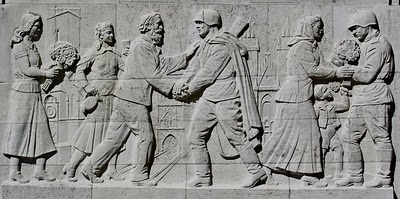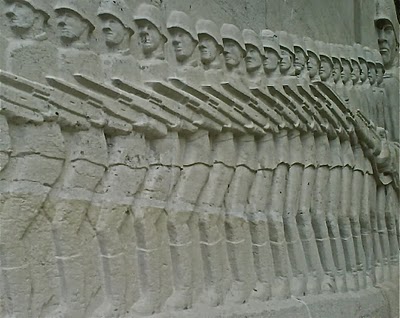Hammers, Sickles and Bones
 The images on the sarcophagi of the Treptower Park Soviet Memorial (Sowjetische Ehrenmal,1949) are idealised and classical, and very very still. There is no sense of movement in these idealised faces. It is as if the images are copied from daguerrotypes, the subjects asked to stay frozen a long time as their proportions are reproduced. The story of the Second World War depicted here is not furious movement but a waiting game.
The images on the sarcophagi of the Treptower Park Soviet Memorial (Sowjetische Ehrenmal,1949) are idealised and classical, and very very still. There is no sense of movement in these idealised faces. It is as if the images are copied from daguerrotypes, the subjects asked to stay frozen a long time as their proportions are reproduced. The story of the Second World War depicted here is not furious movement but a waiting game.

The reliefs are as still as the dead. 80 000 Soviets fell during the Battle of Berlin, and over 7 000 are buried under this memorial. At times the place feels space-age (soaring red gates, like a temple discovered by Cosmonauts), then Liliputian (a massive soldier crushing a swastika underfoot), and then at others Spartan (the joyless sacralising of the fallen on the cenotaphs). Mosaic flowers are scattered, untouched by wind, over the funeral pavement.
I am not a great fan of the Red Army or of Joseph Stalin, no surprise. Having recently read the anonymous memoir Eine Frau in Berlin about mass rapes committed by Soviet soldiers after the fall of Berlin, I think sarcophagal images of ‘Victory’ (defeated Germans greeting Soviet soldiers with flowers) must have been intolerable to the humiliated. ‘Grateful’ was not the feeling:

The memorial is a breathtakingly monumental act of propaganda. And yet, one is also aware of the tremendous sacrifice, and achievement, of the Soviet army: the crushing of Hitler’s serial occupation of Europe. The importance of this victory gives the Treptower Monument its dissonance. What a strange feeling it is to come to a place which represents the defeat of one of history’s most evil regimes and to hesitate before mourning the fallen.

The Soviet War Memorial now feels like a deconsecrated church, a place that has lost its religion. Skateboarders use the graves to launch their stunts. And under, the bodies of countless young men, who fought and freed Europe from a tyranny meant to last a thousand years, lie motionless.


Pingback: Hitler’s Bloody Palace: Mohrenstraße | The Needle: Berlin